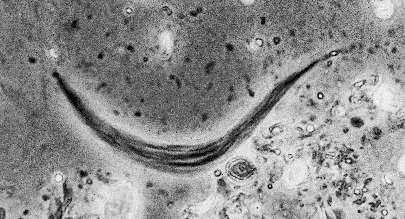Introduction to the Basal Eukaryotes

A number of eukaryote lineages
that branched very early in eukaryote evolution are still
extant today. Most of them have no fossil record at all. However,
studying these protists is important for what it can tell us about the
earliest steps in eukaryote evolution. These primitive eukaryotes
are also important in medicine and veterinary science: some cause
human and animal diseases such as giardia (hikers' diarrhea) and
trypanosomiasis (African sleeping sickness). Yet others
live in symbiotic relationships with other organisms: the
flagellate Streblomastix shown above lives in the intestines
of termites, and it and several
other
protists assist in the digestion of wood.
The relationships among these protists were not clear until the
advent of techniques such as electron microscopy and DNA sequencing.
A picture of the "family tree" of the early eukaryote lineages is just
beginning to arise. For now, we will simply
list some of the important groups of basal protists, and provide sources
of additional information on the Internet.
- Amoeboflagellata -- Sometimes called the Schizopyrenida,
amoeboflagellates are small, colorless protists. Most can transform
between amoeboid forms (known as trophozoites)and flagellate
forms; an amoeba that encounters water
can grow two flagella and swim away, reverting to the amoeba stage upon
encountering food (in most species, the flagellate cannot feed).
Amoeboflagellates can also form
cysts that are resistant to extreme conditions; these can lie dormant
for decades before returning to life. Amoeboflagellates thus can live
in changeable habitats; they may be extremely common in soils. A few
species that are adapted to live at human body temperature are normally
free-living but can cause serious and usually fatal brain infections if
introduced into the body -- fortunately, this is rare. Comparisons of rRNA
sequences have shown that amoeboflagellates are most closely related to
euglenids and to kinetoplastids. Their fossil record is extremely sparse
and extends back to the Cretaceous.
- Diplomonadida -- Diplomonads are small heterotrophic protists
with no mitochondria. Some diplomonads are free-living and may be common
in stagnant fresh water, but most are commensal in the
intestines of animals. Some are parasitic and cause disease; in humans, the
diplomonad Giardia infects the intestine and can cause diarrhea
(a disease known as giardiasis, or "hiker's diarrhea").
Although diplomonads have no hard parts and completely lack a fossil
record, recent studies of
the ribosomal RNA of diplomonads have shown that they form one of the
earliest branches of eukaryote evolution.
- Euglenida -- Euglenid protists are generally elongated cells that
possess one or two flagella; there are about 1000 species. While
many are
photosynthetic and have chloroplasts, some euglenids lack
chloroplasts and are colorless. The euglenid cell is covered by a flexible
coat, the pellicle, that allows the cell to change shape; euglenids
can swim using their flagella but can also creep using a peculiar type of
"inching" locomotion known as metaboly. Most known euglenids live
in shallow freshwater habitats enriched in organic matter, but some live
in marine or brackish waters, and a few are parasitic in animals. Aside
from one possible Silurian fossil,
a curious microfossil called Moyeria, the sparse fossil record of
euglenids is restricted to the late Tertiary.
- Kinetoplastida -- Relatives of the Euglenida, kinetoplastids
include two main groups of
small, flagellated protists: the bodonids, which are free-living and common
in freshwater habitats, and the parasitic trypanosomes. The
best-known trypanosomes are those in the genus Trypanosoma
that cause human diseases such as sleeping
sickness (in equatorial Africa) and Chagas' disease (in South America).
A related protist, Leishmania, causes the disease leishmaniasis, or
kala-azar. These
trypanosomes are transmitted by biting flies, and are a serious public
health problem in much of the world. Molecular studies have shown that
kinetoplastids are probably related to the euglenids and amoeboflagellates.
They lack a fossil record.
- Parabasalia -- Parabasalians are found only in association with
animals. Some are pathogens; for instance, the parabasalian species
Trichomonas vaginalis causes a fairly common sexually transmitted
disease in humans. Parabasalians are more commonly
found as commensal or beneficial symbionts; other species of Trichomonas
live commensally in the human mouth and gut. Parabasalians also include
many
forms found in the guts of
roaches and termites.
These protists in turn contain symbiotic bacteria that break down cellulose,
and some of these parabasalians move by means of thousands of symbiotic
bacteria attached to their outer membrane and propelling the host forward.
It is because of these protists and their bacterial symbionts that termites
are able to feed on wood.
Parabasalians lack mitochondria, and all are anaerobic.
- Pelobionta -- Pelobiontids, or karyoblasteans,
are large (up to 1 mm long), free-living amoeboid protists
living in freshwater muds in temperate habitats in the Northern Hemisphere.
Only about four species exist, all in the genus Pelomyxa -- and three
of these species may turn out to be synonymous with the first species
described, Pelomyxa palustris.
Pelomyxa can tolerate very low oxygen levels; these protists
lack mitochondria completely, but contain several types of
symbiotic bacteria that fulfil the same function. Pelomyxa thus shows
what eukaryotes were like at a very early stage in their evolution, before
the appearance of true mitochondria. No fossils are known.
For more information:
Visit the Tree of Life for more information about the relationships among the
basal eukaryotes.
Or visit Cells Alive! for information about parasitic microbes.

Source: Margulis, L., Corliss, J.O., Melkonian, M. and Chapman, D.J.
(eds.) 1991. Handbook of Protictista. Jones and Bartlett, Boston.
This photograph of Streblomastix was provided by Erol Kepkep.






